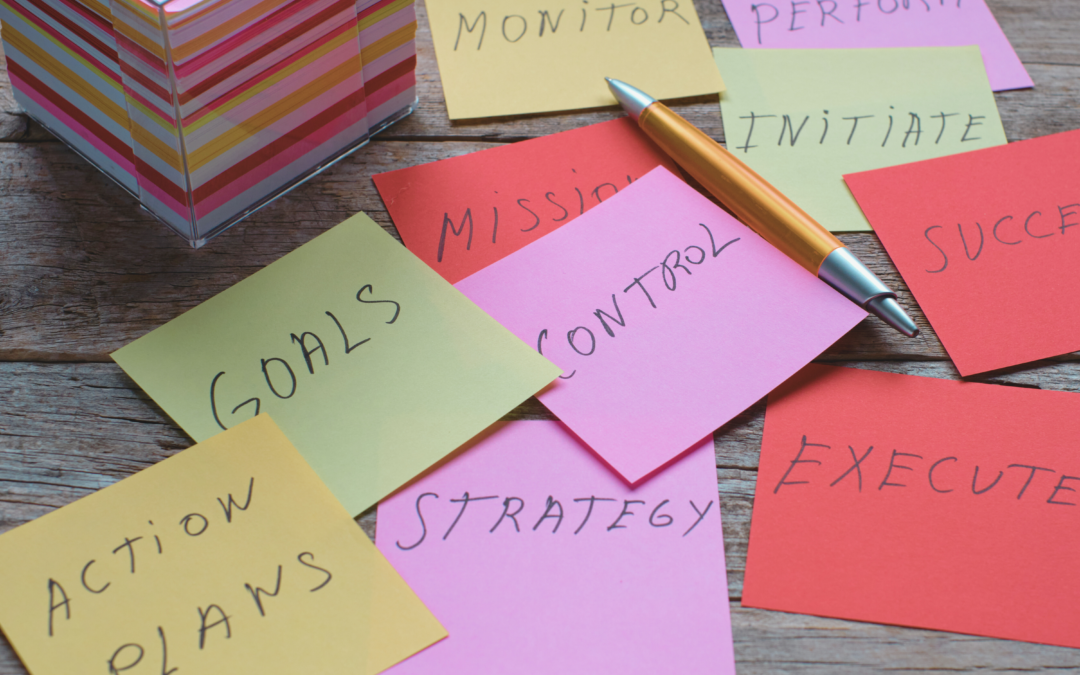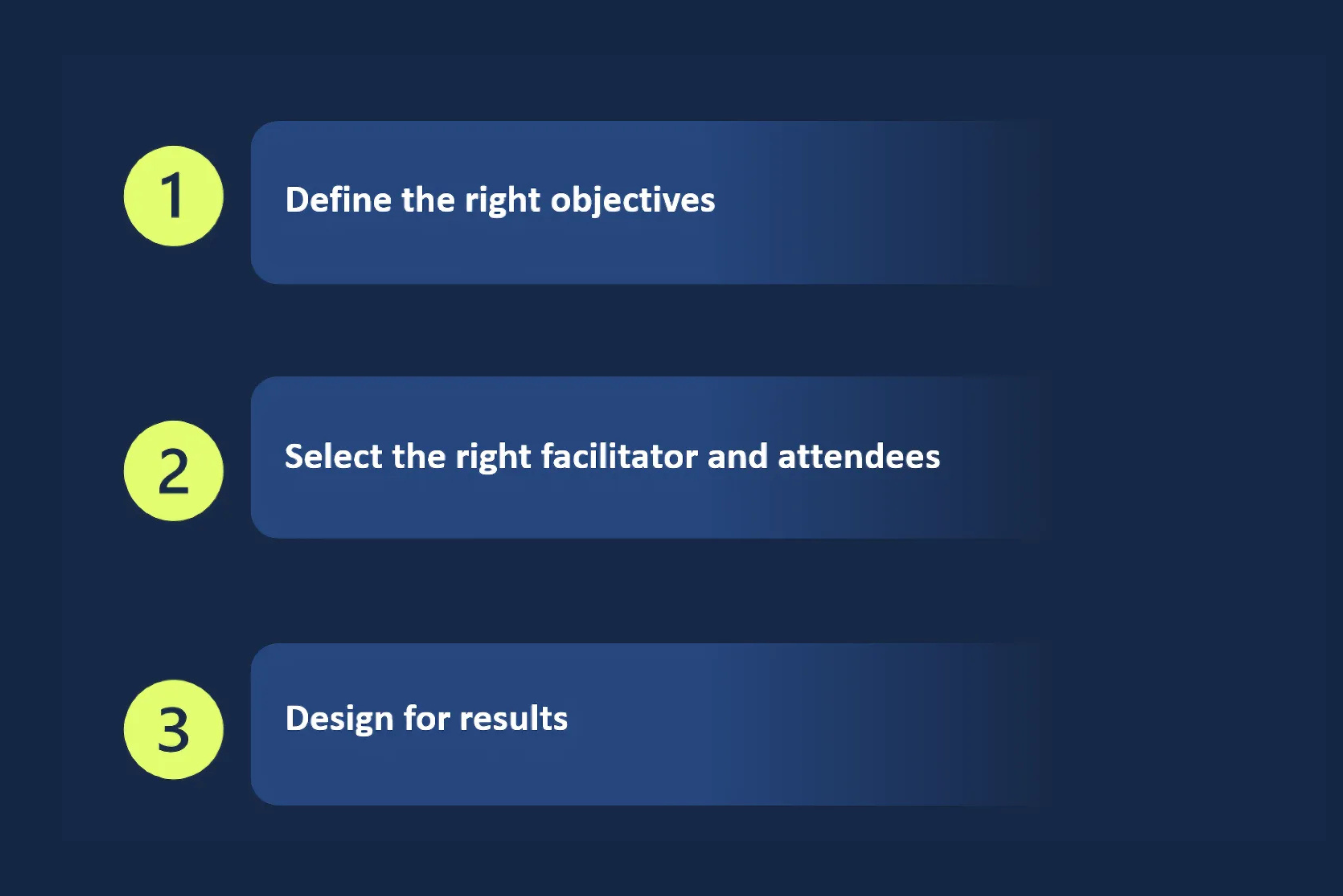Most away days arise out of a simple ‘feeling’ that one would be helpful – but that feeling usually reflects a larger organisational need. There could be a significant reset moment on the horizon, a new initiative, role changes, or a big decision that needs input from a large number of people.
At their best, away days can bring people together, align them on a set of facts, generate ideas, or move towards decisions in an inclusive way. They emphasise active participation, usually last up to a full day, and are held outside the usual workspace (even if it’s not somewhere too exotic for cost reasons!).
We think there are three essential steps for planning a successful away day. Get these right and your day’s likely to have the impact you want.
1. Define the right objectives
Away days are most energising when you set a clear, reasonably ambitious goal for the day – with key questions to tackle across different sessions.
“They designed and delivered a hugely professional and inspiring session that helped to focus the team on how our day-to-day work delivers for the core purpose of what we’re seeking to achieve. They ran us through exercises that challenged us on our long-term focus.“
– Deputy Director, Central Government Department
To do this:
- Start with a strategic mindset. Ask which problems or questions are critical to resolve for the organisation or team.
- Identify the right level of ambition given the time available. If this is the first step in designing a complex change programme, you might focus your session on gathering input or ideas from a less senior group. If you’re trying to make decisions, recognise how difficult this will be – significant work will be needed in advance and sessions must be shaped carefully to assess options.
- Focus on what people truly care about. Away days only work when the objectives matter to most participants. Before the day, interview a representative sample of attendees, test the issues they care about, and understand group dynamics. Or at the very least, use an anonymous survey to get this input. The ‘senior owner’ of the day can then take this into account when designing the day and the agenda.
- Be flexible on focus. What’s important can change quickly! Leapwise recently designed and facilitated a senior Home Office senior team away day, but the General Election was announced a few weeks before the session. We switched focus to issues like managing election periods and political transitions, which energised attendees.
- Pass the Daily Mail test. Team–building or rewarding staff are perfectly valid away day objectives. However, for public sector organisations, it’s essential that the day delivers for the public and would seem acceptable to them, if journalists wrote about it.
2. Select the right facilitator and attendees
Wherever possible, we recommend leaders delegate session design and facilitation to others. This gives leaders space to think and listen during the away day and get the most out of the sessions. It can also – with the right facilitator – make attendees more willing to speak up.
“Having this away day facilitated like this was like flying first class or being in a chauffeur-driven car. It gave me proper space to think, step back and contribute. I never want to facilitate my own away day again!“
– Director, Central Government Department
To do this:
- Find people with a track record of running effective workshops – though an experienced generalist with the knowledge and authority to encourage senior leaders to participate can work too. What’s crucial is that they’re comfortable initiating difficult conversations and injecting energy into activities.
- Free up the time to be successful. People usually underestimate how much time’s required to deliver a successful away day. For a one-day session with 20 people, 3 days’ prep (this might not be directly before the away day) and 1 day of follow-up works well.
- Provide admin support. Venue hire, scheduling, and on-the–day admin can add up, especially for large events. A logistics lead should work directly with the design lead to minimise this burden.
- Don’t separate away day design and facilitation. Effective facilitators must understand the desired outcome of each exercise and guide participants towards those goals. Having several people involved in design can help for generating ideas, but the facilitator must be involved early – even if they’re not carrying all the work.
- Go external when needed. Use professional facilitation when participants are senior, topics are very sensitive, you lack the skills or time in-house, or you need something different after a few ‘flat’ sessions you’ve run internally.
- Help attendees feel able to contribute. Creating a flat structure which offers psychological safety can give people the confidence to speak their minds – providing the honest conversations needed for a successful day. Not mixing seniority levels in the same group can be helpful too. For larger groups, splitting the day up can work well: start with sessions for everyone with senior staff briefed to be in ‘listening mode’, then split into one senior leaders session with separate sessions for others, and conclude with both groups back together to share conclusions.
3. Design for results
Away day design is both art and science and the details really matter.
“They brought together a really fresh and engaging programme, and challenged us in a good way to think outside of the box. We have had very positive feedback from Commissioners. I would thoroughly recommend them.“
– CEO, Association of Police and Crime Commissioners
To do this:
- Interview a sample of attendees. As above, assess what’s important to attendees, understand key debates, and explore group dynamics as you design the day.
- Make it interactive. Our work evaluating board and governance meetings shows that ‘share of voice’ is the single biggest driver of satisfaction. Use break-out groups, paired discussion exercises, and interactive tools to give everyone a chance to share. Don’t overdo the tech – post-its can work as well as the best online capture tools – and avoid repeating exercise types too much, to keep things fresh.
- Capture insights as you go. The best sessions create meaningful products as they go along, like a draft timeline for a plan, stakeholder maps, or lists of ideas and options.
- Plan for action. Agree follow–up and timelines with assigned actions for individuals, as part of your away day sessions. Plan your post-event comms in advance to make sure you build on momentum from the day.
- Prepare for standard facilitation challenges. Agree ground rules with participants that they’ll follow on the day, reflecting the group dynamics. Prepare techniques to keep everyone engaged and discussions from wandering too far off-topic.
- Refine and rehearse. Test and refine your agenda with the away day facilitator or team and sign it off with senior leaders. Never go into an away day without the facilitation team doing a run–through – ideally checking the tech too!
With all these building blocks in place – not to mention refreshments and a good lunch! – your away day will be set up for success. And, if you’re preparing an away day anytime soon and need some expert support, don’t hesitate to reach out to our team.

